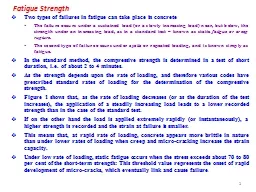

The failure occurs under a sustained load or a slowly increasing load near but below the strength under an increasing load as in a standard test known as static fatigue or creep rupture ID: 917760
Download Presentation The PPT/PDF document "Fatigue Strength Two types of failures i..." is the property of its rightful owner. Permission is granted to download and print the materials on this web site for personal, non-commercial use only, and to display it on your personal computer provided you do not modify the materials and that you retain all copyright notices contained in the materials. By downloading content from our website, you accept the terms of this agreement.
Slide1
Fatigue Strength
Two types of failures in fatigue can take place in concreteThe failure occurs under a sustained load (or a slowly increasing load) near, but below, the strength under an increasing load, as in a standard test – known as static fatigue or creep rupture.The second type of failure occurs under cyclic or repeated loading, and is known simply as fatigue.In the standard method, the compressive strength is determined in a test of short duration, i.e. of about 2 to 4 minutes.As the strength depends upon the rate of loading, and therefore various codes have prescribed standard rates of loading for the determination of the compressive strength.Figure 1 shows that, as the rate of loading decreases (or as the duration of the test increases), the application of a steadily increasing load leads to a lower recorded strength than in the case of the standard test.If on the other hand the load is applied extremely rapidly (or instantaneously), a higher strength is recorded and the strain at failure is smaller.This means that, at rapid rate of loading, concrete appears more brittle in nature than under lower rates of loading when creep and micro-cracking increase the strain capacity.Under low rate of loading, static fatigue occurs when the stress exceeds about 70 to 80 per cent of the short-term strength: This threshold value represents the onset of rapid development of micro-cracks, which eventually link and cause failure.
1
Slide2Thus, when the stress exceeds the threshold value, concrete will fail after a period which is indicated by the failure envelop(Fig. 1)
A similar phenomenon takes place under a sustained load where a certain load is applied fairly quickly and then held constant. Above the same threshold of about 70 to 80 per cent of the short-term strength, the sustained load will eventually result in failure. At stresses below the threshold, failure will not occur and the concrete will continue too creep.Now let us consider the behavior of concrete when a compressive stress alternates between zero and a certain fraction of the short-term static strength.There is change in the shape of the stress-strain curve under the alternating load, as the number of load cycles, are increased.(Fig. 2)Initially the loading curve is concave towards the strain axis, then eventually concave towards the stress axis.The extent of this later concavity is reflected by an increase in the elastic strain and, hence, by a decrease in the secant modulus elasticity, a feature which is an indication of how near, the concrete is to failure by fatigue.For a constant range of alternating stress, the fatigue strength decreases as the number of cycles increases. This indicated by the so called S – N curves (Fig 3), where S is the ratio of the maximum stress to the short-term static strength and N is the number of cycles at failure.2
Slide33
Fig 1
Slide44
Fig 2
Slide55
Fig 3